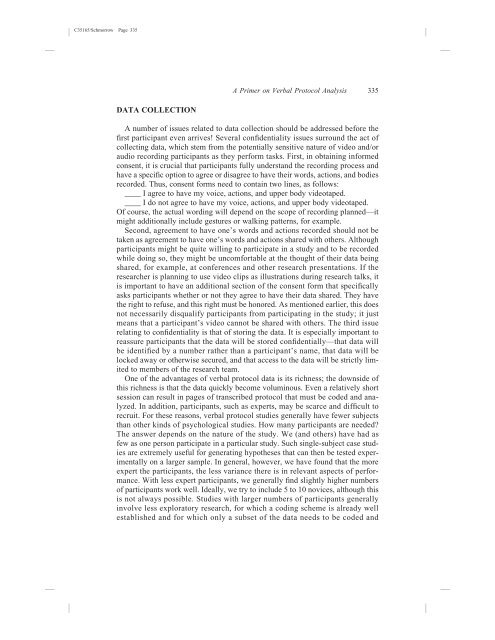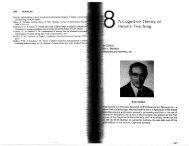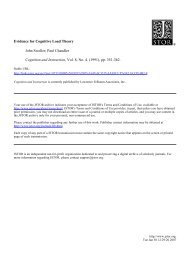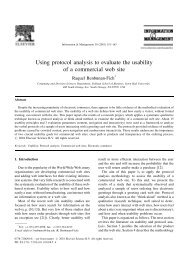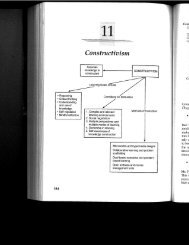a primer on verbal protocol analysis - Ammon Wiemers' Home Page
a primer on verbal protocol analysis - Ammon Wiemers' Home Page
a primer on verbal protocol analysis - Ammon Wiemers' Home Page
Create successful ePaper yourself
Turn your PDF publications into a flip-book with our unique Google optimized e-Paper software.
C35165/Schmorrow <strong>Page</strong> 335<br />
A Primer <strong>on</strong> Verbal Protocol Analysis 335<br />
DATA COLLECTION<br />
A number of issues related to data collecti<strong>on</strong> should be addressed before the<br />
first participant even arrives! Several c<strong>on</strong>fidentiality issues surround the act of<br />
collecting data, which stem from the potentially sensitive nature of video and/or<br />
audio recording participants as they perform tasks. First, in obtaining informed<br />
c<strong>on</strong>sent, it is crucial that participants fully understand the recording process and<br />
have a specific opti<strong>on</strong> to agree or disagree to have their words, acti<strong>on</strong>s, and bodies<br />
recorded. Thus, c<strong>on</strong>sent forms need to c<strong>on</strong>tain two lines, as follows:<br />
____ I agree to have my voice, acti<strong>on</strong>s, and upper body videotaped.<br />
____ I do not agree to have my voice, acti<strong>on</strong>s, and upper body videotaped.<br />
Of course, the actual wording will depend <strong>on</strong> the scope of recording planned—it<br />
might additi<strong>on</strong>ally include gestures or walking patterns, for example.<br />
Sec<strong>on</strong>d, agreement to have <strong>on</strong>e’s words and acti<strong>on</strong>s recorded should not be<br />
taken as agreement to have <strong>on</strong>e’s words and acti<strong>on</strong>s shared with others. Although<br />
participants might be quite willing to participate in a study and to be recorded<br />
while doing so, they might be uncomfortable at the thought of their data being<br />
shared, for example, at c<strong>on</strong>ferences and other research presentati<strong>on</strong>s. If the<br />
researcher is planning to use video clips as illustrati<strong>on</strong>s during research talks, it<br />
is important to have an additi<strong>on</strong>al secti<strong>on</strong> of the c<strong>on</strong>sent form that specifically<br />
asks participants whether or not they agree to have their data shared. They have<br />
the right to refuse, and this right must be h<strong>on</strong>ored. As menti<strong>on</strong>ed earlier, this does<br />
not necessarily disqualify participants from participating in the study; it just<br />
means that a participant’s video cannot be shared with others. The third issue<br />
relating to c<strong>on</strong>fidentiality is that of storing the data. It is especially important to<br />
reassure participants that the data will be stored c<strong>on</strong>fidentially—that data will<br />
be identified by a number rather than a participant’s name, that data will be<br />
locked away or otherwise secured, and that access to the data will be strictly limited<br />
to members of the research team.<br />
One of the advantages of <strong>verbal</strong> <strong>protocol</strong> data is its richness; the downside of<br />
this richness is that the data quickly become voluminous. Even a relatively short<br />
sessi<strong>on</strong> can result in pages of transcribed <strong>protocol</strong> that must be coded and analyzed.<br />
In additi<strong>on</strong>, participants, such as experts, may be scarce and difficult to<br />
recruit. For these reas<strong>on</strong>s, <strong>verbal</strong> <strong>protocol</strong> studies generally have fewer subjects<br />
than other kinds of psychological studies. How many participants are needed<br />
The answer depends <strong>on</strong> the nature of the study. We (and others) have had as<br />
few as <strong>on</strong>e pers<strong>on</strong> participate in a particular study. Such single-subject case studies<br />
are extremely useful for generating hypotheses that can then be tested experimentally<br />
<strong>on</strong> a larger sample. In general, however, we have found that the more<br />
expert the participants, the less variance there is in relevant aspects of performance.<br />
With less expert participants, we generally find slightly higher numbers<br />
of participants work well. Ideally, we try to include 5 to 10 novices, although this<br />
is not always possible. Studies with larger numbers of participants generally<br />
involve less exploratory research, for which a coding scheme is already well<br />
established and for which <strong>on</strong>ly a subset of the data needs to be coded and


